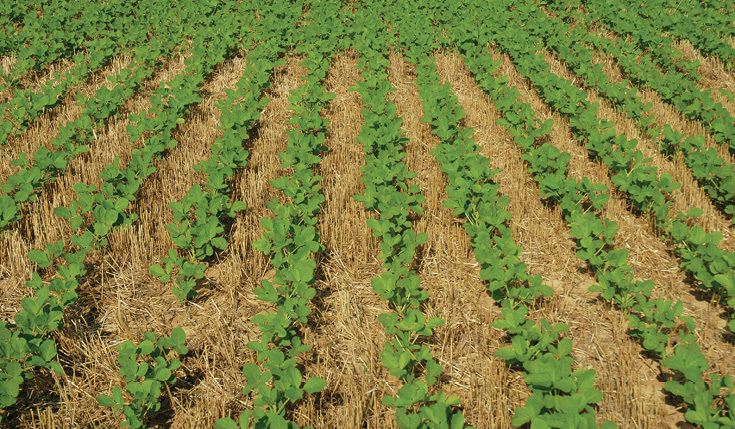Pictured Above: Double-cropping veterans John and Alexander Young of Herndon, Ky., say double-cropping systems cover the soil, improve soil health, ward off pests and diseases and protect profits. Find out more about their keys to success here.
With wheat prices on the rise and the 2020 harvested U.S. wheat acreage at what is likely to be the lowest total on record, there appear to be some good economic opportunities for no-tilling this small grain crop this fall. This is particularly true for no-tillers who can double-crop wheat with soybeans.
An analysis of University of Illinois crop budgets for 2021 for the southern area of the state indicates no-tilling soybeans after wheat may out-perform growing either corn or soybeans alone. Illinois ag economists Gary Schnitkey and Krista Swanson, along with Ohio State University ag economist Carl Zulauf, worked up their latest economic analysis based on current 2021 grain bids.
In southern Illinois, a combination of wheat and double-crop soybeans is projected to be more profitable than either corn or soybeans grown alone. In addition the economists determined that growing wheat alone is considerably less profitable than producing either corn or soybeans.
Data in the accompanying chart for southern Illinois growers is based on prices of $5.40 per bushel wheat, $9.30 per bushel soybeans and $3.50 per bushel corn.
Schnitkey says operator and land returns in this analysis represent the return to both the farmer and landowner. If land is cash rented, then the cash rent amount would need to be subtracted from the operator and land returns to arrive at the farmer’s share. Property tax and mortgage interest would be subtracted from operator and land returns if the farmer owned the land.
Their analysis for southern Illinois growers projects the operator and land returns for wheat grown alone will be only $17 per acre. This is based on a 68 bushel per acre wheat yield, which is the average estimated yield for Illinois in 2020.
The $17 operator and land return is well below the $110 return for corn grown alone based on a 187 bushel yield. The economists indicate growing wheat by itself would have to average over 85 bushels per acre to exceed the return from corn.
The $17 per acre return for growing wheat is also below the $132 operator and land return for soybeans. For wheat to exceed stand-alone soybean returns, wheat yields would have to be more than 89 bushels per acre.
Wheat, Double-Cropped Soybean Returns
With a wheat and soybeans double-crop combination, soybean yields are set at 43 bushels per acre, based on data from records among Illinois Farm Business Farm Management members who double-crop beans. Combining wheat yields of 68 bushels per acre with double-crop soybeans offers a projected return of $179 per acre. This is higher than the $110 per acre return for corn or $132 per acre with soybeans.
From 2014-2019, Schnitkey says operator and land returns for southern Illinois farmers averaged $103 per acre for corn, $181 per acre for soybeans and $157 per acre with wheat and double-cropped wheat and soybeans.
“On average, wheat-double-crop soybeans have been more profitable than corn in recent years, but less profitable than soybeans,” he says. “However, current 2021 bids cause wheat-double-crop soybeans to be more profitable than soybeans and corn.”
Farther North, Different Results
For central Illinois growers with highly productive land, the incentive for double-cropping is considerably different for corn or soybean acres.
With corn yields of 220 per bushel, the operator and land returns work out to $237 per acre. With 68 bushel soybean yields, the operator and land return is $297 per acre. Wheat yields of 85 bushels per acre work out to a projected operator and land return of $112 per acre.
With double-crop yields of 85 bushels for wheat and 43 bushels of soybeans per acre, the operator and land return is projected at $256 per acre in central Illinois on highly productive land. This represents a $19 per acre higher double-crop return than for growing corn, but $41 per acre less than the 2021 projected operator and land return with soybeans alone.
With relatively firm prices when compared with corn, no-tilling wheat this fall offers more profit opportunities than in the past few years. This is particularly true for no-tillers located in areas where next year’s wheat harvest can be immediately followed with double-crop soybeans.








